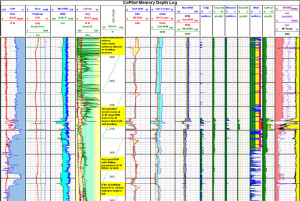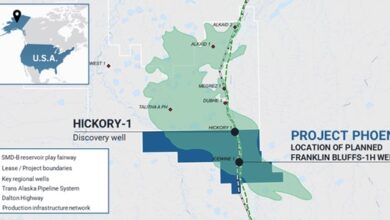Real-time drilling service halts twist-offs in Wolfcamp wells
Sensor sub provides window to downhole dynamics leading to damaging vibrations, guides changes in drilling parameters, tools
By Scott Masson and James Hood, Baker Hughes

An operator in the Permian Basin requested Baker Hughes to provide a real-time drilling performance service due to numerous drill string twist-offs occurring on both of its rigs operating in the area. This focus area is the Delaware Basin, with wells located near the Texas and New Mexico border in the counties of Reeves, Loving and Culberson, Texas. The focus was on the intermediate vertical section of planned unconventional horizontal wells, targeted in the Wolfcamp and Phantom Wolfcamp shale. The Wolfcamp shale is the largest producing shale play in the US, based on cumulative and estimated reserves.
Strong oil prices and the advancement of unconventional exploration technologies have led to a rapid growth of drilling in the Wolfcamp, attracting more than 245 of the 545 rigs in the Permian. This growth has reduced availability of experienced drillers and, coupled with localized drilling challenges, contributed to the twist-off events. To help bridge the gaps in experience and deliver a tailored solution, drilling guidelines needed to be reviewed and implemented in addition to an enhanced engineered drilling system.
While cutting the rock during the drilling process, vibration is inevitable and expected. The choice of the drilling system, including the bit and drive system to power the bit, influences the vibration modes generated. In general, roller cone bits are expected to produce axial vibration from percussion, and drag bits, such as the PDC, produce higher levels of tangential vibration or friction in the rock destruction phase. Extreme forms or motions of these expected vibrations, such as bit bounce and stick-slip along with whirl and lateral vibration, would be harmful to the drilling process and system. In this case study, both stick-slip and whirl were identified as extreme harmful motions that caused damaging vibrations in the vertical sections.
Controlling the type of vibration produced during the drilling process first depends on having a measurement system to identify any abnormal occurrence. The second phase is implementing drilling parameter changes in real time using preset guidelines. The third phase is to implement improved engineering of the system along with additional guidelines for the driller.
To help identify and understand the drilling challenges, the Baker Hughes CoPilot real-time drilling optimization service was selected. This short, modular sensor sub can be used on its own or integrated into the bottomhole assembly (BHA) to gain real-time downhole dynamics understanding of vibration and dysfunctional motion information. This also includes mechanical data – weight on bit (WOB), torque, rotational speed (RPM), bending moment, bending orientation, rotational inclination, motor speed, bore and annular (ECD) pressure with differential pressure and downhole MSE. Placement of the sub can be optimized for specific applications, yielding insights into the effects of downhole mechanics and dynamics. This technical solution is complemented with real-time engineering expertise.
The CoPilot was planned to be used on the intermediate vertical section of six wells and with the first hole drilled by every new rig that the operator added to the Permian area.
The operator requested the CoPilot data be transmitted in real time, requiring a bi-directional communications and power module to power and transmit the data to surface. Baker Hughes provided a rig floor display and incorporated the information into the surface data system to be displayed throughout the rig and remotely to the operator. Additionally, a team of wellsite experts was added to interpret the data and advise drillers on parameter management. The first wells’ intermediate vertical hole size was 12 ¼ in., the typical hole size used for all previous wells in the Permian. The drilling system incorporated a PDC bit and an 8-in. straight positive displacement motor with a pendulum arrangement of stabilizers to help keep the well path vertical.
CoPilot data over the course of the first vertical section identified that this drilling system was unstable and produced numerous backward whirl events, which produced high lateral vibration and bending moments. Due to past experiences, the operator’s wellsite representative wanted the drill string to be rotated in excess of 100 RPM, which added to lateral dynamic dysfunctions and was not needed with the motors’ rotation speed of approximately 150 RPM.
As the whirl events occurred, Baker Hughes wellsite experts advised that the drill string RPM be reduced to 20-40 RPM and ensured the WOB was increased with a corresponding decrease in flow to help stabilize the bit and BHA.
This advice halted each whirl event as it occurred. The completion of the first well resulted in no twist-offs, and the operator was alerted to the instability of the 12 ¼-in. system. Subsequently, the intermediate vertical hole section size was changed to 10 5/8 in., which helped decrease the lateral movement of the 8-in. BHA. The real-time interpretation of the CoPilot data during the course of the next five wells highlighted minimal backward whirl events in the 10 5/8-in. hole size.
Despite the success of the hole size change, interpretation of the CoPilot data identified common backward whirl events while placing and pulling the bit on and off bottom for a connection. To help reduce whirl, improved guidelines were established to enhance the process and stabilize the drilling system. The processes adopted for connections were reviewed, and recommendations were identified to keep the drill string RPM low at 20 RPM until WOB was established and drilling continued. Prior to each new connection, the RPM was decreased to 20 RPM before reducing WOB and lifting the bit off bottom.
The development of on- and- off-bottom procedures offered improved control of the lateral dysfunctions and resulted in significant longevity in the life of the drill bit. Throughout the drilling of the wells, the Baker Hughes drilling performance expert engaged with each driller to ensure understanding and implementation of the new drilling processes.
On the third well, the operator attempted to use an aggressive bit that produced high reactive torque from the mud motor (stick-slip). In this scenario, it was advised to decrease the WOB and increase the flow to minimize the vibration. After a number of stick-slip events, the bit was worn down and pulled before reaching section TD.
To prove that the problem was the bit selection, the motor was removed with only a few hundred feet remaining in the section. A similar-style bit produced high levels of stick-slip again, and the wellsite operator would not attempt to use lighter WOB and higher RPM to overcome the stick-slip. The operator has not used this aggressive bit again in the Permian.
During the course of drilling these wells, concerns were raised regarding the errors of zeroing the surface WOB. Too much WOB could cause the motor to stall or stick-slip to be induced, thus wearing the bit sooner than expected. Too light of WOB would cost the operator additional time due to a slower ROP. The real-time interpretation and practice of using the CoPilot’s downhole WOB allowed the operator to drill more efficiently, optimizing weight transfer to the bit.
The use of the CoPilot’s rotational inclination headed off the need for any wellbore corrections to take place. Identifying that the inclination was building above 3 ½° per 40 ft before a survey tool allowed the driller to lighten the WOB, which with a pendulum assembly allowed the inclination to drop back to zero. This continuous early warning allowed for a much smoother vertical wellbore.
With the learnings from the first four wells, the operator requested the CoPilot to be used in the 8 ¾-in. vertical hole section of the last two wells prior to kick-off point for the lateral section. Before the sixth well, remaining bit wear issues led to designing a specific Baker Hughes bit that enabled the drilling of the entire 10 5/8-in. and 8 ¾-in. hole sections in one run, each with a Baker Hughes motor and CoPilot guidance.
Six wells’ vertical sections were drilled without any twist-offs, and the process was enhanced to improve performance by using only one bit per section. Using these combined solutions saved this operator 24% of the projected well costs and provided valuable leanings for drilling additional wells more economically and safely.
CoPilot is a trademark of Baker Hughes.




